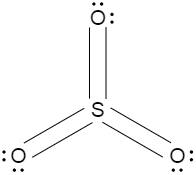
Draw the resonance hybrid of $S{{O}_{3}}$
Answer
558k+ views
Hint: The concept of resonance was formerly introduced in order to deal with the kind of difficulty experienced in the depiction of accurate structures of molecules.
The phenomena of resonance is represented by a double headed arrow. Each structure of resonance has an equal contribution to the resonance hybrid structure and no individual structure is totally responsible for the final structure.
Complete step by step answer:
According to the concept of resonance, whenever a single Lewis structure cannot describe a molecule accurately, a number of structures with similar energy, positions of nuclei, bonding as well as non-bonding pairs of the involved electrons are taken as the resonating structures of the hybrid which describes the molecule accurately.
In the given structures, we can see that the double bond characteristics of the sulphur and oxygen is not present at any one oxygen, it keeps on delocalisation, or in other words, the pi electron cloud present in the double bond, keeps on delocalisation and shifting between the three oxygen atoms which are attached to the sulphur.



We can see that the Lewis structure, in each of them the sulphur has a formal charge of $+2$ and two of the oxygen atoms have $-1$ charge.
Now, in each of the three structures which are present in the middle, we can see that the $S$ has a formal charge of $+1$ and one of $O$ atoms has a formal charge of $-1$.
Now if we consider each of the structures present at the bottom, the formal charge is zero.
Note: The phenomena of resonance results in stabilisation of a molecule, as the electron clouds are more delocalised throughout the whole molecule, and no electron cloud is localised in just one atom.
Due to which the energy of the resonance hybrid is much less as compared to the energy of any single resonating structure.
The phenomena of resonance is represented by a double headed arrow. Each structure of resonance has an equal contribution to the resonance hybrid structure and no individual structure is totally responsible for the final structure.
Complete step by step answer:
According to the concept of resonance, whenever a single Lewis structure cannot describe a molecule accurately, a number of structures with similar energy, positions of nuclei, bonding as well as non-bonding pairs of the involved electrons are taken as the resonating structures of the hybrid which describes the molecule accurately.
In the given structures, we can see that the double bond characteristics of the sulphur and oxygen is not present at any one oxygen, it keeps on delocalisation, or in other words, the pi electron cloud present in the double bond, keeps on delocalisation and shifting between the three oxygen atoms which are attached to the sulphur.



We can see that the Lewis structure, in each of them the sulphur has a formal charge of $+2$ and two of the oxygen atoms have $-1$ charge.
Now, in each of the three structures which are present in the middle, we can see that the $S$ has a formal charge of $+1$ and one of $O$ atoms has a formal charge of $-1$.
Now if we consider each of the structures present at the bottom, the formal charge is zero.
Note: The phenomena of resonance results in stabilisation of a molecule, as the electron clouds are more delocalised throughout the whole molecule, and no electron cloud is localised in just one atom.
Due to which the energy of the resonance hybrid is much less as compared to the energy of any single resonating structure.
Recently Updated Pages
Why are manures considered better than fertilizers class 11 biology CBSE

Find the coordinates of the midpoint of the line segment class 11 maths CBSE

Distinguish between static friction limiting friction class 11 physics CBSE

The Chairman of the constituent Assembly was A Jawaharlal class 11 social science CBSE

The first National Commission on Labour NCL submitted class 11 social science CBSE

Number of all subshell of n + l 7 is A 4 B 5 C 6 D class 11 chemistry CBSE

Trending doubts
Differentiate between an exothermic and an endothermic class 11 chemistry CBSE

10 examples of friction in our daily life

One Metric ton is equal to kg A 10000 B 1000 C 100 class 11 physics CBSE

Difference Between Prokaryotic Cells and Eukaryotic Cells

1 Quintal is equal to a 110 kg b 10 kg c 100kg d 1000 class 11 physics CBSE

State the laws of reflection of light




